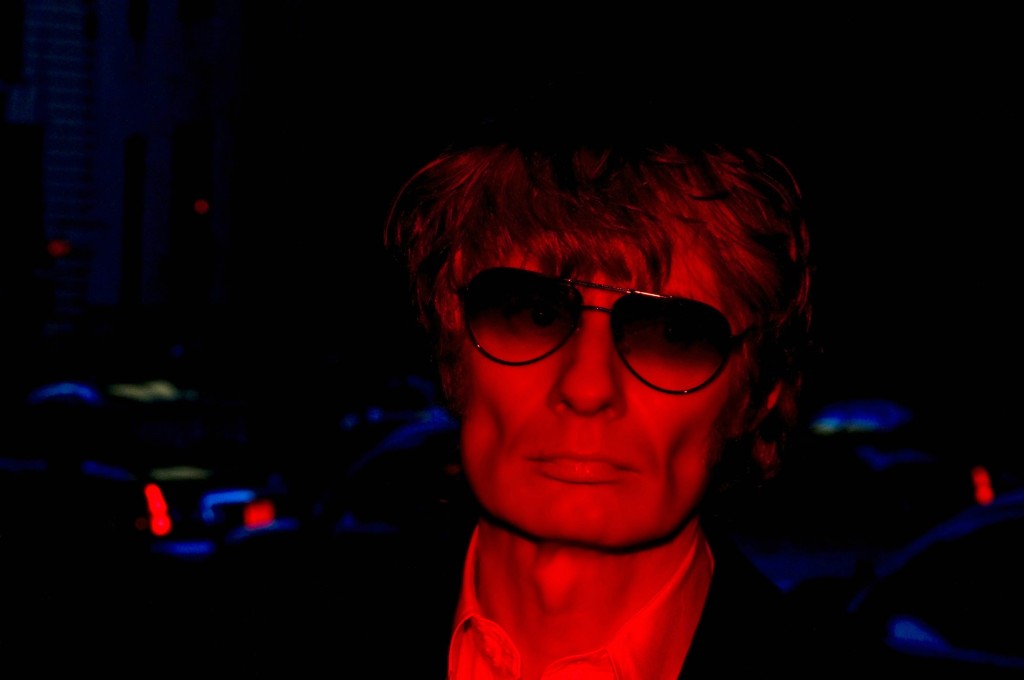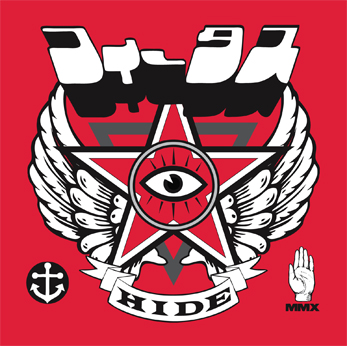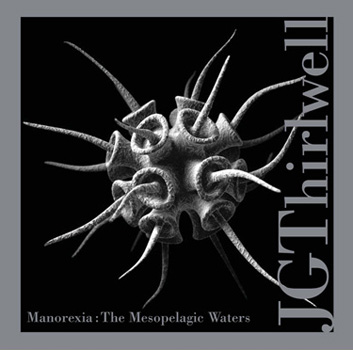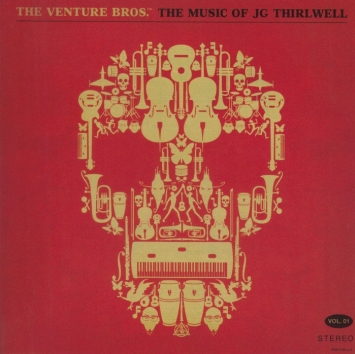Genuine virtuosos are a rare breed. They defy categorization simply by existing. Their visionary ingenuity radiates from their work in spades, and effortlessly so. It can come at a price, in terms of their creations being lost on society at large, but in a world fraught with rules and restrictions prescribed by self-proclaimed authorities from bygone times, true personal liberty is a gift. It enables the individual to continuously evolve in a progressive manner, free from the unnatural constraints human beings have unwittingly imposed upon themselves.
JG Thirlwell’s extraordinary career has spanned over 30 years, and his momentum shows no signs of flagging. In fact, I’d say he’s hit full stride, and will continue to ascend. The self-taught, sui generis composer has been creating unparalleled, captivating, thought-provoking music under various names – including Foetus, Manorexia, and Steroid Maximus – for the better part of his life. Instead of providing a detailed biography here, I recommend visiting his informative and engaging website at www.foetus.org to get the facts.
Photo © 2011 Tony Visconti
I’m a highly intuitive creature, and often can’t explain what it is about a vital force – human or creative – that I find magnetic, but the attraction is almost always instant. JG Thirlwell first riveted my attention in the late 80s, and still has a firm hold on it, here in the 12th year of the 3rd millennium. I find his music and the ethos behind it so incredibly stimulating I felt inspired to put it in writing. The original idea was for an in-depth interview to be featured in a future book. I was then struck with the idea of incorporating my usual rambling lunacy into an exploration of his most recent work, and the effects it may have after being conjoined with it in the Isolation Tank that is my world when I’m in full-scale creative mode. The “Delysid” for the journey was four of JG’s albums – HIDE, The Mesopelagic Waters, Dinoflagellate Blooms, and The Venture Bros: The Music of JG Thirlwell – all prodigiously imaginative, succulent aural feasts that clearly demonstrate the amplitude of his preternatural talents. I engaged in a musical orgy with the polycephalous organism while plowing through an intensely demanding phase, both personally and creatively. I knew I’d be affected by the experience, but had no idea how or to what degree.
What you’re about to read is an experiment designed to reanimate the writer and expose my unfamiliar readers to the phenomenon that is JG Thirlwell. To begin with: It’s not a review, but a personal voyage composed in a meandering, self-indulgently subjective manner, with necessary and relevant information sprinkled throughout. I don’t follow any ordinances when it comes to writing. Whether it’s fiction or nonfiction, and whatever the subject, I approach it all in the same freeform way. The only requirements are resonance, inspiration, and love. While I can certainly appreciate the purpose of the critic, I feel that panning music I dislike is a waste of time and energy. I also feel that dissecting music I’m enamored by can demolish what I find so enchanting about it. I’m not big on comparisons either, whether drawn to other artists or an artist’s own work. I understand why people need to make them, particularly when writing reviews, but I often find them lazy, assumptive, and reductive. Other than actually listening to JG Thirlwell’s music first-ear, I believe it can only be described with a single, tailor-made, yet-to-be-coined adjective that exists in a language spoken by another species in an alternate universe. For the purpose of our journey, I’ll use whatever and however many words necessary to sing my piece, in English, as spoken by humans on Planet Earth. JG’s voice will be interjected throughout as well. Once my personal experiences were documented, he provided some illumination, based upon a combination of my unrestrained curiosity and nescience in terms of the more “technical” aspects.
* * * * *
Foetus, JG Thirlwell’s longest running project, is the apotheosis of independence, having blazed a broad trail while demolishing all boundaries along the way. Born in 1981, the output has been refreshingly diverse and consistently outstanding. Remarkably expansive in scope, Foetus has tackled and mastered a gamut of styles, all the while communicating at a profound level both musically and lyrically. The fact that JG single-handedly composes, arranges, produces, sings and plays nearly all of the instruments makes it even more impressive. Then there’s the striking artwork that encases each release, which he’s also solely responsible for. Much of the substantial discography remains in regular rotation in my world, and I continue to be blown away with every listen. With the latest addition, HIDE, he’s ventured into new territory once again, and triumphed.
HIDE was the driving soundtrack, and as luck would have it, I’d acquired a brand new automobile with a cosmic eight-speaker sound system shortly before the disc made its way into the magick slot. Described by JG as “a neo-symphonic avant-psychedelic concept album informed by the culture of fear,” HIDE kicks off with an Olympian operatic bang that dominates the listener’s attention for nine glorious minutes, before flawlessly weaving its way through a kaleidoscope of musical realms, including progressive, contemporary classical, even western all’italiana. A sonic warlocks’ brew of harmonious incongruity, HIDE reconfirms that whatever form JG’s music takes, it has a distinct soul with a fierce heartbeat. Majestic, mercurial, and unrelentingly passionate, the album is truly alive. It breathes, thinks, feels, and possesses the expressive abilities of a living being. I was enraptured with the first intoxicating dose, and it immediately became the intra-aural drip, providing salvation from gridlock’s devitalizing fangs.
I view life as a surreal and occasionally absurd seriocomedy that alternates between live action and animation. When I’m behind the wheel, the 3105-pound mass of humanmade materials becomes a simulator, and the windshield, an interactive screen. Music can significantly enhance the experience, which was engendered with a peculiar hobby I took up at age 15, fondly referred to as Pole Position: driving after dark with sunglasses on while under the influence of LSD. I’ve long since ditched the shades at night, and thankfully, controlling substances stopped working many moons ago. In the years since, I’ve relied heavily upon music to produce the more desirable effects drugs once afforded, including escapism, which still plays a vital albeit healthier role in my life. HIDE provided the means of transportation, unfalteringly, from start to finish. Each song is a singular masterpiece in its own right, and when the album is devoured as a whole, it becomes an impressively stirring score for traveling into the paracosms. I was swept up and away into the heights of my imagination, which is a celestial place to be, especially when I record the resultant deluge of ideas before they spill out of my ear when I tip my head. I’ve always viewed JG’s Foetus creations not only as cinematic, but dramat(urg)ic as well, with HIDE now leading the pack in that respect. By day three, my long dormant pipe dream of staging an unprecedented, groundbreaking, arcane musical was revived. In fact, I devised nearly every detail of the grotesquely spectacular and grandly misunderstood sleeper while traveling to and from the gym every morning.
HIDE also succeeded in arousing a gamut of emotions – from euphoria to Weltschmerz – and proved to be a powerful Sehnsucht trigger, becoming poignantly painful at times, as I haunted that place I once inhabited, but have yet to find. I’ve been running away to “Home” since materializing on Planet Earth. I believe it’s a place that does exist, and through music I’m able to visit in the metaphysical sense. Although it can be difficult, it’s a welcome and salubrious state to be in every now and again. Surrendering to it requires letting go of the safety bar, and coasting down that seemingly endless spiral slide, knowing that your conscious self will catch you at the bottom. What sets HIDE apart from the old reliable stimuli, and more important, above, is that it’s a terra incognita. There are no graphic memories associated with it, whereas the others are inextricably linked with particular chapters of my life that were written in indelible ink.
In line with my earlier, entirely subjective gibberish about critics, I rarely read reviews of any kind, and aside from the article that appeared in my publication, Paraphilia Magazine, I haven’t read much press about JG. Since it’s human nature to classify and draw comparisons – particularly to an artist’s previous work – I’m going to assume that he hasn’t been spared. Having gorged on the majority of his Foetus creations over the years, one word pops into my mind: Evolutionary. The development has been continuous and progressive, as it should be.
JG provided some insight into the creative process that fuels and guides the mighty Foetus machine.
“HIDE took several years to make. The Foetus albums are becoming increasingly harder to make, because I’ve already created a universe of Foetus, and I don’t like to repeat myself. I want the project to move forward and progress and be fresh and surprising, so there’s a lot of self-criticism and self-analysis involved with finding where that project is going to go. When it happens, there’s a Eureka! moment, and it falls into place, but it can take literally years for that to happen. There was an entire year while I was working on HIDE that I wrote only one piece, which was “Here Comes the Rain.” So the album really gestated in knowing where I wanted it to go. I think there is some relationship to the previous album Love, maybe a through line to a certain extent, but in other ways I threw out the rule book with HIDE. It was only the second time I had a guest vocalist, Abby Fisher, who’s an opera singer I’d seen performing with various people, including John Zorn and Ted Hearne. I wanted to do some works in an operatic direction, and she was the first person I thought to call. The idea of putting her voice in the forefront like that was something I’d never done before.
I find with the Foetus albums, I’ll write with a couple of ideas in mind for things I might want to do, and then at a certain point I have what I call “tent poles,” which are the major signifying compositions that are going to be the backbone of the album, tell me the direction of the album, and give the album its identity. Once I have the tent poles in place, then I listen to that and think about what sort of album I want to make. Then I start thinking about the other pieces I want to write, which will create the arc of what I want to do. Once those tent poles are in place, it makes the whole process go a lot faster, and that’s usually when the concept behind the album becomes apparent. It emerges, as it did with HIDE, which is a concept album, and the concepts came about organically, because that’s what I was obsessed about. These were things that seeped through from my consciousness, and I really can’t help that, because the Foetus albums really are a diary of where I was at the time.”
[vimeoresponsive id=”23917571″]
Manorexia is JG’s experimental instrumental project that’s often described as cinematic and textural. The words innovative, complex, startling, and heady come to mind as well. Like a potent conscious-expanding drug, Manorexia takes the listening experience three steps further with its powerful influence on the mind’s eye. The human brain is transformed into a personal cinema, where the film continually changes and develops, prompting the irresistible desire to make repeated visits to see where it leads.
With the most recent albums, The Mesopelagic Waters and Dinoflagellate Blooms, JG’s outdone himself yet again. As is usually the case when I’ve been completely wowed, I felt impelled to share the brilliance. The first person who came to mind was filmmaker and kindred being E. Elias Merhige (Begotten, Shadow of the Vampire, Din of Celestial Birds) who I knew would be equally impressed:
“Díre! Thank you for tuning me into these fine sonic pieces. They really sculpt these imaginal landscapes that pull you in before you even have a chance to realize what is happening. This music called up for me some of the earlier works of Stravinsky. I love the primality of the works. They evoke the emotions of nature not of man/woman. An echo of the beginnings of things. Thank you so much.”
Perhaps these virtuosic minds will collaborate someday? One can certainly hope. I think JG’s created some of his most inspired and compelling work with Manorexia and the potential seems limitless. Conceived in 2001, the project has spawned four albums and numerous performances. Originally devised for the studio, JG explains how Manorexia evolved into the live wonder it’s become.
“I made two Manorexia albums – Volvox Turbo and The Radiolarian Ooze – in 2001 and 2002. I had thought for some time about how I wanted to realize the project live, and my initial impulse was that I wanted to do it as a string quartet with percussion. I proposed that as a project to David Sefton at UCLA, but then we switched it into my Steroid Maximus big band project. The string quartet with percussion idea was still rolling around in the back of my mind. Then I had an invitation to go to Russia in 2006, and that seemed to be the right opportunity to realize that way of interpreting some of the Manorexia material. I worked with an arranger, revoicing some of the pieces, and then went over there with the Real Quiet Ensemble – percussionist David Cossin, cellist Felix Fan and pianist Andrew Russo – as the core of the live Manorexia experience. We added two violins and viola over there, Russian players, and that was the first time I realized Manorexia live. Then, back in New York, I enlisted a bunch of musicians, and started to perform it live there, while slowly adding arrangements and expanding the universe of what I could do with that type of instrumentation.
I never wrote the material with the intention of it being performed live, but there is a lot you can do with string quartet. I think it’s an amazing selection of instruments that integrate and complement each other really well, and you have a great deal of variety of feel of scope and timbre and emotion of what you can do with that. I really enjoy writing for strings, so Manorexia developed for a while, and the third album, The Mesopelagic Waters is a representation of where it was at with the arrangements I had done up to that point. I’m continuing to work with Manorexia and have added a few new arrangements since then. I can’t realize everything I do with a live ensemble, because it’s not always possible to make arrangements of the material.”
The Mesopalegic Waters, released on John Zorn’s Tzadik label, features eight tracks taken in equal parts from the first two Manorexia albums – Volvox Turbo and The Radiolarian Ooze – and radically rearranged. An anomaly in JG’s oeuvre, it was recorded live in the studio with a chamber ensemble – string quartet, percussion, piano, and laptop – with very few overdubs, with the intent of capturing the live Manorexia experience as closely as possible. Richly infused with a variety of sounds, from finely layered nuances to imposing discord, the listener is carried through a range of tones, timbres, and moods, all overlapping and converging fluidly throughout, even amid the more chaotic moments. There’s a necessary ever-present tension that sways, ebbs and flows, grabbing and releasing in fits and starts. The keys move about from graceful accompaniment into full-scale hammering, while the strings vacillate between weeping, attacking, and communicating calmly and lucidly, refusing to be ignored all the while. Hauntingly beautiful, intensely evocative, and agreeably unsettling at times, I fell head over heels for The Mesopelagic Waters, and kicked myself for taking so long to meet with it.
The latest addition to the Manorexia catalogue, Dinoflagellate Blooms, complements The Mesopelagic Waters superbly. Released on JG’s own Ectopic Ents label, it features eleven tracks composed, produced, recorded and performed entirely by JG Thirlwell, with the exception of track one, which features a guest musician on autoharp and piano strings. Described as an album that “careens between soft plucked interludes to full blown symphonic frenzy, from musiq concrete nightmares to cinematic mindfields, with a meticulous marriage of samples and live instruments, distressed sounds and mysterious unknown quantities,” I found it enthralling, disturbingly appealing, and strangely cathartic. My very first thought was: Someone needs to create moving pictures to accompany the music without compromising its indispensible identity. Then I was engulfed by the sonic billows. There is so much happening simultaneously from beginning to end that each subsequent listen has proven to be a unique experience, with previously unnoticed details either creeping up or leaping out. The album is a wondrously rich, rhythmic collocation of sounds that navigates its way through a sea of moods – from suspenseful swells to dreamy wistfulness to tempestuous upheavals. Throughout it all, one constant remains: a vital intensity.
JG also designed and produced the exquisite artwork for the two-disc set, which includes a traditional stereo CD as well as a 5.1 surround sound DVD – the ideal way to undergo the experience, as he explains.
“I’ve been doing a lot of multi-channel sound installation works, where you position speakers around a room, as many speakers and channels as you want, with different sounds discretely coming out of different speakers. It creates an immersive environment, as opposed to stereo where you have only two channels. Increasingly working in that environment where you can sit in a room and be surrounded, enveloped, and immersed in the sound is part of my reason for releasing the album in the 5.1 format, as well as the idea that listening is an active experience as opposed to passive. My music is definitely not passive, and not background music, even when it seems contemplative or pastoral, it’s still very much foreground music. The 5.1 format is embracing something that’s more immersive and enveloping, which runs counter to the way a lot of music is consumed now. I think music has become so omnipresent that it has become a less important experience to a lot of people. It’s become an accessory, and to nearly everything. It’s in every store you go into, it’s in the background of every website you open, it’s on the train, it’s on the plane, it’s in the bank, it’s everywhere. For me, making a 5.1 album is making a point about sitting down and listening actively and becoming engaged in what you’re really listening to. Although I think music is very much at the forefront of some people’s lives, unfortunately, a lot people seem to view music is as content and not as a passionate form of expression, whereas I can’t really exist unless I can express myself in that way.”
Photo © 2011 Tony Visconti
The Mesopelagic Waters and Dinoflagellate Blooms were ingested as a cocktail, in alternate doses, via headphones, while marching through the ultimate phase of the book I’d been toiling over for eight years. It was another case of fortuitous timing, for I was in the throes of an acute spell of artistic anemia, primarily due to the daunting chapters I was facing, combined with some unanticipated personal stress. I was caught off-guard, and pleasantly so, by the albums’ astonishingly inspiring effects. It was as if I’d been infused with an analeptic that induced prolific creativity. Up until that point, I’d rarely listened to music while writing, and when I had, it was usually music from a particular time that was relevant to the book, which is autobiographical. I did so knowing that my hippocampus would be jolted, resulting in the resurrection of certain memories and the feelings associated with those memories. After my experience with these two Manorexia albums, I have my own theories about music’s potential effects on the brain that may not be explainable in scientific terms.
As The Mesopelagic Waters and Dinoflagellate Blooms poured into my ears, mercilessly yet lovingly permeating every crevice of my psyche, activating all the right circuits in the process, I immediately realized I’d been doing myself a serious disservice by going with the obvious soundtrack. Besides the fact that the music’s cinematic nature harmonized with my propensity for writing in a cinematic way, my inordinately boundless mind was blown open even further. If it weren’t for the tether, it would have floated away into a cerebral interstellar cloud. I was able to tap into, visualize, and express memories, thoughts, and emotions I’d entombed another lifetime ago. Recapturing states, which I know from vast/past experience, are only reachable via certain drugs or severe trauma. Exploiting those states for the sake of “art” requires yielding to the subconscious and being prepared to face whatever may be conjured up, no matter how disturbing or harrowing it may be. With The Mesopelagic Waters and Dinoflagellate Blooms guiding the gurney, I felt inexplicably obligated to do so, perhaps because I knew there would be a reward, which there was and then some. The words were gushing out of my head quicker than I could type them. Yet at the same time, I was uncharacteristically focused. I ultimately became hooked on the TMS/DB cocktail, reaching a point where I couldn’t make any progress without it stroking my tympanic membranes.
Like HIDE, The Mesopelagic Waters and Dinoflagellate Blooms were equally successful in seducing my limbic system, which I’m pleased to say is fully operational. The ability to feel is a gift that far too many waste by choosing to anesthetize with a variety of numbing agents, not limited to drugs. It’s been my experience that the rawest beauty can often be found in those tenebrous regions that appear to be formidable, but are, in fact, beneficially challenging. Emotions that could be classified as “uncomfortable” or “unbearable” remind me that I have a pulse. When experienced in healthy doses, that is. I’ve never been easily stimulated, and spent a significant chunk of my life throwing down the gauntlet to any force that attempted to impose mortality. It began with habitual childhood daredevilry that carried over into my adolescence, which was one prolonged game of Chicken with Thanatos. As an adult, art has become my primary source of kicks. Whatever the medium and overall tone – dark, upbeat, and all that dwells in between – it needs to mesmerize, galvanize, overwhelm, and strike a range of chords, which both albums do to a phenomenal degree.
The Manorexia material is lavishly orchestrated and profuse in thought, emotion, and detail, yet also exudes a natural fluency. Clearly the work of a master who’s set high standards for himself, as evidenced by the fact that Dinoflagellate Blooms was several years in the making.
“I started working on Dinoflagellate Blooms and HIDE around the same time. My intentions would go on one for a while, then on the other for a while. There was a writing phase – which unfortunately is the fire that many artists have to walk through – where you’re creating material that you hate, and you think, ‘Okay, that’s it, I’ve had a good run, but my creative days are over. I’m never going to do anything good again, and I may as well give up right now.’ Unfortunately that’s the fire you have to walk through to get to the other side, to that elusive piece that is going to break the damn, and make you say, ‘Yes! This is something worthwhile!’ With Dinoflagellate Blooms, there were half a dozen pieces I wrote that I hated, and I thought, ‘Maybe I just can’t do this anymore?’ Then one piece came along and I said, ‘Okay, this is it!’ That piece turned into ‘The Perfect Patsy.’ Then I went back and reevaluated one or two of the pieces I had thought were disastrous, and found that they weren’t so disastrous, so then I reworked those. One in particular, ‘Vika,’ made it onto the album.”
[vimeoresponsive id=”22993978″]
[vimeoresponsive id=”22992780″]
Since 2004, JG has been scoring the animated television series, The Venture Bros, which airs on Cartoon Network’s Adult Swim channel. In 2009, the first volume of the show’s soundtrack, appropriately entitled The Venture Bros: The Music of JG Thirlwell, was released on Williams Street Records. Composed, arranged, produced and performed by JG Thirlwell, with a handful of guest musicians on select tracks, it would be an understatement to say that the music is perfectly capable of standing on its own. The album flows and segues smoothly and impeccably, while maintaining an uncompromising level of energy. It also serves as further testament to JG’s (super)natural gift for capturing, manipulating, and seamlessly blending a variety of sounds, sources, and styles – Western, calliope music, classical, electronica, funk, various forms of jazz, etc – into one heterogeneous nectar, thereby creating his own inimitable “genre” – which again, can’t be defined in conventional terms.
The Venture Bros: The Music of JG Thirlwell began as the soundtrack for my daily Thorazine injection – also known as “the morning workout” – and eventually made its way into my car(toon). Since I hadn’t seen the series, I cannonballed into the punch bowl with a tabula rasa, only knowing that the album would be on a par with the rest of the composer’s oeuvre. A musical gigacoaster – encased in a colossal funhouse – complete with overbanked turns, boomerangs, tunnels, corkscrews, and hills galore, it served as both a shot in the arm, and a delightful addition to the previously mentioned driving soundtrack.
While on the road, the enervating zombie flick that is So Cal traffic mutated into a phantasmagoric animated film, providing much-needed diversion. JG’s music has always propelled my mind into otherworldly regions, sparking my imagination in the process. When I finally got around to reading the liner notes, I was not at all surprised to learn that the scores have played a key role in the development and direction of The Venture Bros series.
There were moments that led to introspection as well, particularly amid the endorphin surges while I was burning rubber on my treadmill. It was far more starry-eyed, though, similar to where my head often went as a child, way up into the clouds, where the Spanish castles breathe. As I zipped along, I found myself dreaming about building an outré theme park simply so JG could provide the music for the place. And if I happen to bump into a few billion bucks, that fantasy will become a reality, mark my words.
The mentality required to score a television series could be at odds with an artist like JG, who epitomizes the word “independent” in its truest sense, but The Venture Bros suits him to a tee. He’s not only met all possible challenges, but creatively capitalized as well.
“Doing the TV show, one is called upon to be creative on demand. I’m coming from a different place creatively than working on my own stuff, because there are parameters I’m working within that are dictated by the show, the visuals, the director’s vision. It’s different, but a lot of the music and ideas have come through my universe, and I also get a chance to explore universes that are dictated by the nature of the show, which has given me a chance to make a musical vocabulary for The Venture Bros that bounces from ideas that I’ve touched on before, specifically with Steroid Maximus. When I approach a cue, there are parameters. The cue has to be a certain length of time, a certain tempo, it has to create a certain mood. I might look at it and say, okay it’s a minute and 30 seconds long, but 45 seconds of it have to be a beat to let a piece of dialogue through and then there’s a scene change, and it has to be sad, and then come back with a big ending. So, I’ll have this roadmap of what should be happening, and then I’ll decide on the tempo, the key, and then there you go. In some ways it’s problem solving, but also when I’m taking away some of the choices of what the piece is going to be, it really frees up a different creative energy.”
[vimeoresponsive id=”22132926″]
[vimeoresponsive id=”22130589″]
I can say with absolute certainty that I emerged from the voyage in an improved state. Beyond the sheer delectation of spending hours getting intimately familiar with the music, I was deeply moved and mentally invigorated. As for the strides made on my book, it’s undeniable that JG’s music served as a creative torch, guiding my mind into the penetralia of my soul, where the wraiths and demons reside. The offspring that will be unleashed in the near future would have been a different animal without that flame leading the way, a fact that will be acknowledged in print.
With HIDE, The Mesopelagic Waters, Dinoflagellate Blooms, and The Venture Bros: The Music of JG Thirlwell, JG Thirlwell has proven, once again, that he is indeed a marvel who exists in a class of his own. Viewing all four albums as one beautifully protean, multi-polar organism, I’ll summarize with the creature with the following four words: Transcendence that beggars description. I also think the music is entirely accessible to anyone who approaches it with an open mind. Remove the blinders and filters, leave the need for safety, familiarity, and compartmentalization at the door, and allow the divinely provocative beast to caress, massage, and shake your cerebral cortex in the most sublime way. Follow that advice when entering and I guarantee you’ll be fascinated, if not hooked.
Photo © 2011 Tony Visconti
To purchase HIDE, The Mesopelagic Waters, Dinoflagellate Blooms, and The Venture Bros: The Music of JG Thirlwell, as well as other selections from JG Thirlwell’s extensive catalogue, please visit his shop at: http://foetus.org/content/shop
Thank you again to the ever lovely, multitalented Tony Visconti for the beautiful, soul-capturing photographs, more of which can be seen in PARAPHILIA MAGAZINE ISSUE 13.
Essays Music Reviews Video







Good Article! Fan since 1988!